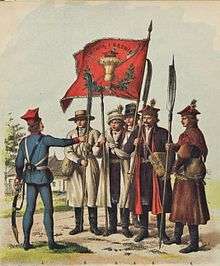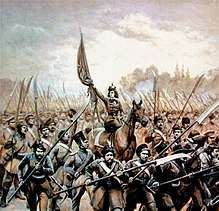Kosynierzy
Kosynierzy (singular: kosynier; sometimes translated as scythe-bearers or scythemen, from Polish kosa, scythe) is the term for soldiers (often peasants) armed with war scythes. First appearing in the Kościuszko Insurrection of 1794, kosynierzy quickly became one of the symbols of the struggle for Polish independence.


History
The term comes from the Polish language. In Poland the kosynierzy formations are best remembered for their decisive role in the Battle of Racławice, 1794, during the Kościuszko Insurrection.[1][2] Through this battle, well known in Poland, and because of Kościuszko's influence and pro-peasant stance, the kosynierzy became one of the symbols of the fight for Polish independence, as well as a symbol of self-identification of the peasantry with the Polish nation.[2][3][4][5] One of the kosynierzy, Wojciech Bartosz Głowacki, recognized for his bravery in the battle of Racławice, became one of the most famous Polish peasants, a symbol in his own right, attracting what some described as a cult following.[1][6]
The tradition of the kosynierzy would be commemorated through peasant-staged battle reenactments, statues, poems, and plays.[7]
During the Kościuszko Uprising, most of the peasants who joined the kosynierzy units came from the Kraków region, inspired by the Proclamation of Połaniec that Kościuszko issued there. Local quartermasters issued a simple uniform to them, based on the Kraków regional peasant garb (white sukmana dress, plus a cheap military rogatywka cap in red). This garb soon became traditionally associated with the kosynierzy.[8]
Despite the popular myth, the kosynierzy were only a support formation in Kościuszko's forces during the uprising; they formed a majority of troops in only one infantry regiment.[9]
Kosynierzy units also fought in the November Uprising of 1830–31, the Kraków Uprising of 1846, the January Uprising of 1863–64, and possibly as late as during the German invasion of Poland of 1939.[10] Though less remembered, the kosynierzy's participation in the November and January Uprisings were likely more significant than during the Kościuszko Insurrection.[11]
References
- C. M. Hann; Paul R. Magocsi (2005). Galicia: A Multicultured Land. University of Toronto Press. p. 119. ISBN 978-0-8020-3781-7.
- HALINA LERSKI (1996). Historical Dictionary of Poland, 966–1945. ABC-CLIO. p. 488. ISBN 978-0-313-03456-5.
- C. M. Hann; Paul R. Magocsi (2005). Galicia: A Multicultured Land. University of Toronto Press. p. 125. ISBN 978-0-8020-3781-7.
- Longina Jakubowska (2012). Patrons of History: Nobility, Capital and Political Transitions in Poland. Ashgate Publishing, Ltd. p. 227. ISBN 978-1-4094-5663-6.
- Alex Storozynski (2009). The Peasant Prince: and the Age of Revolution. St. Martin's Press. pp. 196–197. ISBN 978-0-312-62594-8.
- HALINA LERSKI (1996). Historical Dictionary of Poland, 966–1945. ABC-CLIO. p. 165. ISBN 978-0-313-03456-5.
- C. M. Hann; Paul R. Magocsi (2005). Galicia: A Multicultured Land. University of Toronto Press. pp. 122–123. ISBN 978-0-8020-3781-7.
- Zdzisław Żygulski, Henryk Wielecki, "Polski mundur wojskowy", KAW, Kraków1988, ISBN 8303014838, p. 49.
- Marian Maciejewski, ""Broń strzelecka wojsk polskich w latach 1717–1945", Wydawnictwo Glob, Szczecin 1991, ISBN 8370070663, p. 23.
- "Encyklopedia PWN – Sprawdzić możesz wszędzie, zweryfikuj wiedzę w serwisie PWN – kosynier". Encyklopedia.pwn.pl. Archived from the original on 2014-04-07. Retrieved 2013-08-19.
- Włodzimierz Kwaśniewicz, "1000 słów o broni białej i uzbrojeniu ochronnym", MON, Warszawa 1981, ISBN 8311076669, hasło "Kosa bojowa", p. 114
| Wikimedia Commons has media related to Kosynierzy. |